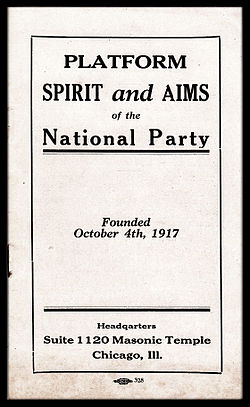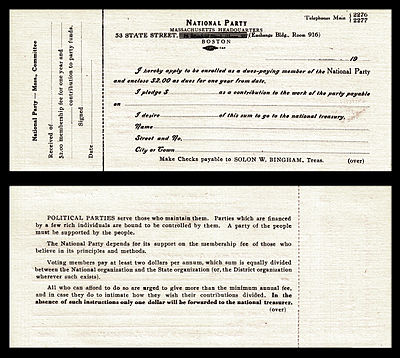- National Party (United States)
-
The National Party was an early-20th-century national political organization in the United States founded by pro-war defectors from the Socialist Party of America in 1917. Rather than filing into the Democratic Party, these adherents of the SPA Right first formed a non-partisan national society to propagandize the socialist idea called the Social Democratic League of America. Many of these individuals were eager for the formation of an alternative political organization to both the so-called "old" parties and the anti-war Socialist Party of America and eagerly latched on to a burgeoning movement for a new party that sprouted in 1917.
Contents
Organizational history
Origins
The National Party seems to have begun as a byproduct of personal coalitions around single-issue advocacy, such as the drive for constitutional amendments for woman suffrage and prohibition. Coming together to lobby Congress and the Wilson Administration on behalf of these measures, activists came to realize their common vision in practical terms, despite whatever philosophical differences they might have harbored in the theoretical plain. Thus veterans of the Progressive Party believing in the "spirit of 1912," Prohibitionists, suffragists, Single-Taxers, and Socialists began to talk amongst themselves about the possibility of uniting their forces in a new political organization to advance their common cause.[1]
Informal conferences were held in New York and elsewhere in the country during the first half of 1917 between these individuals, culminating in a more formal four-day gathering in July at the home of Progressive Party leader J. A. H. Hopkins in Morristown, New Jersey. The group did discuss and decide upon the outlines of a program for the forthcoming organization. The New Jersey conference was unable to agree amongst themselves to a name for the organization, so the matter was deferred to a future organizational conference, which ultimately decided upon the name "The National Party" for the new organization.[1]
The National Party was funded by annual dues payments by its members, based according to the means of the party member, but of not less than $2 per annum. One dollar of this amount was to be retained by the national organization to fund its operation, while the other dollar was to rebated to the state organization for its own support. Party members were to receive membership cards and a periodic bulletin was planned. Those not wishing to cast their lot with the organization as full members could gain "sympathizer" status through the purchase of an annual button for fifty cents.[1]
The National Party's national office was located in the Lafayette Building, 138 N. LaSalle Street, Chicago, Illinois. It also had an office for its "Eastern Division" located at 15 E 40th Street, New York City.[1]
Founding Conference, Chicago, Illinois October 3-4, 1917
The founding conference of the National Party adopted a tentative platform declaring for universal and equal suffrage; for strong advocacy of the rights of Initiative, Referendum, and Recall; for the absentee ballot as a means of enfranchising and deradicalizing transient labor; for prohibition of the sale and use of alcoholic beverages; for prison reform; for a system of proportional representation allowing minor parties representation according to voting strength; and for government ownership of transportation, communications, and other natural monopolies.
The conference adopted a declaration in support of American participation in the ongoing World War which declared:
"Fundamentally the war is struggle between the ideals and aspirations of democracy on the one hand, and the ideals and aspirations of autocracy on the other hand. Imperfect though our democracy may be, nevertheless it is one of the most advanced in the world.
"We rejoice in the assurance that in the words of President Wilson we have entered this war for no selfish objects of our own...
"We entered the war to resist international aggression and lawlessness, to establish a permanent basis for international peace, and to aid the movement toward democracy in all lands. Believing that these aims are coincident with the best interests of all free peoples, and even those of the people of Germany, and confident that this nation will not forget these aims nor permit our forces to be used for conquest or imperialistic oppression, we pledge our full and undivided support to our nation and its allies in the pursuit of these aims."[2]The group also called in no uncertain terms for an end to the "unlimited power of censorship now reposed in the Postmaster General," in favor of a less draconian "national council of censorship, upon which the various social reform ad labor movements of the country shall be adequately represented."[3]
First Convention, Chicago, March 6–8, 1918
The Second Convention of the National Party adopted a formal organizational constitution and revised platform for the organization. The group was to be headed by a National Chairman, four Vice Chairmen, and a National Executive Committee of 29. Former Socialist David Coates was elected National Chairman, while J.A.H. Hopkins was elected First Vice Chairman and Chairman of the National Executive Committee.[1]
Name change
Before the 1936 election, the party changed its name to the "Greenback Party", a reference to the 19th-century party of the same name.
Prominent members and associated organizations
- David C. Coates (ex-Socialist Party)
- J. A. H. Hopkins (Committee of 48, Progressive Party)
- Marie Caroline Brehm (Suffragist)
- William F. Cochran (Baltimore real estate developer)
- Upton Sinclair (ex-Socialist Party)
- John Spargo (ex-Socialist Party)
- J. G. Phelps Stokes (ex-Socialist Party)
Footnotes
- ^ a b c d e Tim Davenport, "The National Party (1917 - 1919?)," Early American Marxism Archive, Marxisthistory.org Retrieved February 25, 2007.
- ^ Platform, Spirit and Aims of the National Party: Founded October 4th, 1917. Chicago: The National Party, 1917; pp. 11-12.
- ^ Platform, Spirit and Aims of the National Party, pg. 12.
Categories:- Political parties established in 1917
- Democratic socialist and social democratic parties and organizations in the United States
- Defunct political parties in the United States
- Socialist Party of America
- History of Chicago, Illinois
- 1917 establishments in the United States
Wikimedia Foundation. 2010.


